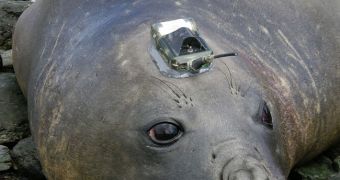They may look like enormous sacks of blubber but one would not easily guess the performances the elephant seals are capable of. The southern elephant seal is the largest seal of all, with the largest males reaching up to 22.5 ft (6.9 m) long and 11,000 pounds (5,000 kg) in weight. Their name is due to their size and to their trunks that enable the males to emit extremely loud roars. They are the largest carnivore mammals in the world (if we exclude whales and dolphins, which are related with the hippopotamuses, not the real carnivores).
But the most amazing thing about them are their diving abilities: they can hold their breath up to 80 minutes and dive up to 1,500 m (4,500 ft) deep in freezing waters. Their capacity to dive to the bottom of the ocean can reveal us many secrets, like crucial clues to increasing changes in global climate. Elephant seals are also known to make long sea journeys.
That's why elephant seals have been equipped with satellite-transmitting devices to help scientists investigate the mysterious water world surrounding Antarctica. These giant marine carnivores and their prey species are very difficult to study, as it is impossible to dive to great depths under the ice in the remote seas surrounding Antarctica; that is why the diet of the southern elephant seals is not clearly known.
An international research team tagged 85 elephant seals, gluing sensors to their fur with epoxy resin. The devices recorded continuously water temperature, saltiness and depth, transmitting these data to satellites each time the seals briefly ascended for air for three to four minutes.
The team had to wait till the end of the mating season of the huge seals, "as they can get quite aggressive, with males fighting over harems and females protecting new pups," explained researcher Martin Biuw, a marine biologist at the University of St. Andrews in Scotland.
The seals were thus tagged afterward, near the end of the summer, when they were much more docile.
"The southern elephant seals ranged across the entire Southern Ocean, swimming thousands of miles a year," Biuw explained.
Tracking the route of the elephant seals pointed the location of the most productive waters loaded with prey species (fish, squids, octopuses). The salt and temperature data gathered by the sensors suggested these waters were filled with nutrients from the water currents that surrounds Antarctica and from under the winter ice pack.
"The fact that we can let the animals themselves measure the oceanography is extremely exciting, being arguably the best oceanographers, since their survival depends on it. Such a strategy will not only help scientists learn more about these creatures but also how the environment they dwell in alters over time due to changes in global climate," said Biuw.
Future updated sensors will permit to record chlorophyll amounts underneath the ocean surface, a measure of photosynthesis and productivity in the Antarctic waters.

 14 DAY TRIAL //
14 DAY TRIAL //